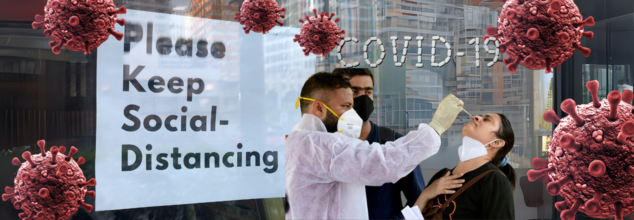- Health Conditions A-Z
- Health & Wellness
- Nutrition
- Fitness
- Health News
- Ayurveda
- Videos
- Medicine A-Z
- Parenting
- Web Stories
India Reports 7 COVID Deaths In 24 Hours As Active Cases Near 5000

Credits: Canva
India is again facing with a familiar warning sign—a spike in COVID-19 cases, localized outbreaks, and fresh deaths. India reported seven COVID-related fatalities in the past 24 hours and recorded 564 new cases, pushing the number of active cases to 4,866 as of June 5, the Ministry of Health and Family Welfare reported. Though still relatively low, the age group spread, spatial concentration, and comorbid condition of the deceased are generating public health signals.
The spike, although not at the level of earlier waves, is significant. Kerala, once the state that was being widely acclaimed for the model response it had followed in the initial phases of the pandemic, now leads the active caseload list with 1,487 cases. Delhi and West Bengal are next with 562 and 538 cases respectively.
Maharashtra (526), Gujarat (508), and Karnataka (436) complete the list of states with more than 400 active cases. These six states collectively account for more than 83% of the nation's present active cases—a stark clustering that indicates the need for focused interventions.
Seven fatalities registered in the last 24 hours present a complicated picture of risk. Of these, three were from Maharashtra, two from Delhi, and two from Karnataka. Importantly, five out of the seven were elderly citizens above the age of 60 with pre-existing conditions like pneumonia, cardiac problems, and states of immunocompromised.
Two of the most troubling fatalities are that of a 42-year-old Delhi man and a five-month-old child from Karnataka. Both were fighting advanced comorbidities when they tested positive for COVID-19, which implies that the virus continues to be opportunistic and targets hardest where there is existing weakness in immunity.
Even while case numbers swell, hospitalization rates are low, and most infections are being treated with home isolation. Nevertheless, the Indian government is not leaving anything to chance. Mock drills were held on June 2 at government hospitals to assess their preparedness.
Sources within the Ministry have also made comments stating that the Centre has asked all states to keep a watchful stockpile of equipment and make sure frontline health workers are ready for any sudden surges.
The distribution of new cases is uneven and appears to be affected, at least in part, by travel-associated exposures. In Madhya Pradesh's Indore, for example, seven new cases were reported—three of them who had recently traveled back from Uttar Pradesh, Odisha, and Kerala.
District epidemiologist Dr. Anshul Mishra confirmed that Indore currently has 17 active cases of COVID, none of which are critical. All of the patients are in home isolation and under observation for symptoms. But the travel connection points to the necessity of continued vigil at domestic transit points.
Likewise, Himachal Pradesh also confirmed its first case in the past weeks, that of an 82-year-old woman who was admitted with COVID-like symptoms at a government medical college in Sirmour. Her case has been closely monitored because of her weak health profile.
Why There Is A Sudden And Sharp Surge In COVID Cases?
What makes this modest but meaningful surge of concern isn't so much the numbers—it's who it is impacting and how. The intersection of at-risk demographics (infants, seniors, and the comorbid), extensive geographical dissemination, and the chronic unpredictability of viral mutations makes waves past come flooding back.
Complacency is another important consideration. With limitations significantly eased, masking now a rarity, and vaccination emphasis on catch-up shots for seniors instead of widespread precautions, professionals fear that individuals are dropping their guard too soon.
The World Health Organization (WHO) continues to emphasize that COVID-19 hasn't gone away and that endemic status doesn't mean harmlessness. Similar to influenza, it remains potentially lethal—particularly for risk groups.
As global surveillance weakens and test rates fall, health officials highlight the importance of ongoing testing and genome sequencing. These are vital measures to track for any new variants that could act in a different way or lower the effectiveness of vaccines.
India's INSACOG network, which is in charge of genomic surveillance, is being called upon to enhance efforts, especially in clusters such as Kerala, Delhi, and Maharashtra.
The resurgence also places an onus on the community. The public must remain aware of:
Early Signs of COVID-19 Infection In 2025
- Getting vaccinated or boosted, especially for those over 60 or with existing health issues
- Doctors also advise basic precautionary steps, such as:
- Wearing masks in crowded indoor settings
- Maintaining hand hygiene
- Avoiding unnecessary travel if unwell
These small but efficacious steps can come a long way in checking further transmission and safeguarding the vulnerable.
This recent increase in COVID-19 infections and deaths is a reminder, not an alarm call. Unlike the first three waves, India today is better prepared with medical facilities, public awareness, and vaccination access but preparedness does not nullify responsibility.
2 Infants Died Of Whooping Cough In Kentucky, Health Officials Report; Who Should Get A Booster Shot?

Two babies in Kentucky have lost their lives to pertussis, also known as whooping cough, as recently reported by the Kentucky Department for Public Health. These deaths, the first pertussis-related since 2018, have refocused attention on a resurging danger once thought largely brought under control in America- vaccine-preventable illnesses.
With over 10,000 cases reported across the country in the first six months of 2025, close to twice as many as the same six months a year ago public health officials are warning an alarm. The epidemic, which tracks with trends in other diseases like measles, coincides with declining childhood vaccination rates, anti-vaccination sentiment, and pandemic-period interruptions of routine vaccination activities.
Whooping cough is a very contagious respiratory infection that is brought on by the bacterium Bordetella pertussis, originally described in 1906 by French scientists. Nevertheless, centuries ago, there were mentions of the illness—its earliest probable epidemic was seen in Paris in 1578.
The disease is notorious for its intense, hacking cough that is followed by a piercingly high-pitched "whoop" upon inhalation. In newborns, particularly those too young to be vaccinated, pertussis may cause lethal complications such as pneumonia, seizures, and respiratory distress. Some doctors call it "the 100-day cough" because its duration lasts for many weeks or even months.
According to the World Health Organization, pertussis still causes approximately 160,700 deaths annually in children under the age of five worldwide, a statistic that highlights the ongoing global burden of the disease, especially in settings with limited vaccine coverage.
The two infants who perished in Kentucky in the last six months were not vaccinated, and neither were their mothers while pregnant. These events highlight a key gap in protection that maternal vaccination seeks to close. Babies under 6 weeks are too young to get their first dose of pertussis vaccine, and so remain extremely exposed early in life.
Third-trimester maternal immunization allows for the passing on of protective antibodies to the newborn, protecting them until they are of age to start their own vaccine regimen. Without the added layer of protection, there is a marked increase in risk of severe illness or mortality.
Through June 2025, the U.S. has reported a minimum of 8,485 confirmed cases of pertussis, already passing the 4,266 cases reported for the same period in 2024. For 2024, as reported by the CDC, a combined total of 35,435 cases were reported—more than five times that of 2023 and close to twice that of 2019, the final year before the pandemic.
Kentucky alone has reported 247 cases of pertussis through 2025, after reporting 543 cases in 2024—the largest number in the state since 2012. Across the country, from October 2024 through April 2025, four deaths from pertussis have been reported: two infants, one school-age child, and one adult.
Why Are Whooping Cough Cases Increasing Again?
The return of pertussis in the United States is being fueled by a mix of related factors. One major cause is the cyclical pattern of the disease, since pertussis has epidemic patterns with episodes peaking every two to five years. Although such peaks are anticipated, experts note that the current peak is more severe compared to what is normally seen during normal peaks. Post-pandemic immunity gap is also a crucial factor. Throughout the COVID-19 pandemic that occurred during 2020 and 2022, pertussis rates decreased significantly because of widespread public health interventions like masking, physical distancing, and closing schools. Since those measures are no longer in effect, numerous persons including children who were left unvaccinated or were missed during their periodic vaccinations since then are now at increased risk for infection. Adding to this problem is the decrease in vaccination coverage, driven by increased misinformation, increased skepticism about the vaccine, and interruptions in access to health care. That decline in immunization, especially in infants and pregnant women, is one of the most urgent priorities driving the national epidemic of pertussis.
How Effective Are Vaccines Against Pertussis?
The pertussis vaccine itself has changed dramatically over the years since it was first introduced in the U.S. in 1914.
Today's acellular form—DTaP for infants and children and Tdap for teens and adults—was introduced in the 1990s as a way to reduce side effects like seizures and high fevers that were caused by the older whole-cell vaccine. Although the acellular vaccine offers robust protection initially, the immunity fades with time. During the first year after completion of the five-dose course of childhood pertussis vaccination, some 98% of children are protected against pertussis.
By the fifth year after the last dose, however, that immunity declines to roughly 65%. This drop highlights the necessity of booster shots in young adulthood and adolescence to ensure sustained protection. While immunity from the current vaccine is not long-term, it still represents the best weapon against severe disease, complications, and mortality. The unvaccinated are 13 times more likely to develop pertussis compared to their vaccinated counterparts, and they have much greater risks of being hospitalized or killed by the disease.
Who Should Be Vaccinated, and When?
The CDC and other top public health organizations suggest:
Infants: Shots at 2, 4, and 6 months, with boosters at 15 months and 4 years.
Adolescents: A Tdap booster dose at 11 or 12 years.
Adults: One Tdap booster in adulthood, with re-vaccination every 10 years.
Pregnant Women: One dose of Tdap between weeks 27–36 of every pregnancy to confer immunity to the newborn through passive antibody transfer.
Local health departments might even suggest extra boosters for people who reside in outbreak-facilitating areas particularly on the West Coast, where states such as California, Washington, and Oregon have seen high case totals this year.
How Can You Protect Yourself and Your Family?
The increase in pertussis cases—and its disastrous effect on babies—underscores the necessity of public education, uniform messaging by health workers, and availability of immunization services. Parents and caregivers should be motivated to keep their own and children's vaccination schedules up to date, especially in communities where disease outbreaks are reported.
Clinicians have a key role in advising maternal immunization and informing families about the signs of whooping cough, which is likely to be confused with the common cold at its initial onset.
Is It The Next Pandemic? New COVID-19 Like Virus From China Raises Global Health Concerns

Credits: Canva
A new strain of coronavirus discovered in China, known as HKU5-CoV-2, could be only a few mutations away from triggering the next deadly pandemic, say American scientists. The virus was identified by researchers at Washington State University (WSU). The researchers have said that it shares close genetic similarities with Middle East Respiratory Syndrome (MERS)—a highly lethal virus that kills nearly a third of those it infects. The findings have raised serious concern in the global scientific community.
A Close Cousin of MERS
MERS, which emerged in 2012 and has caused sporadic outbreaks primarily in the Arabian Peninsula, is known for its severe respiratory symptoms and high mortality rate. HKU5-CoV-2, the new virus under scrutiny, belongs to the merbecovirus family—a group of viruses that includes MERS. While not yet known to infect humans, scientists warn that a minor genetic mutation could allow it to do so, raising the possibility of another global health emergency similar to COVID-19.
“This virus may be only a small step away from being able to spill over into humans,” said Professor Michael Letko, a virologist at WSU and co-lead author of the study.
What the Study Found
The study focused on how HKU5-CoV-2 interacts with human cells. Originally found in bats, this virus was identified by Chinese scientists from the same lab some speculate may have been linked to the origins of COVID-19. In the new study, WSU researchers examined the virus's ability to bind to human ACE2 receptors—proteins located in the nose, mouth, and throat that serve as entry points for coronaviruses.
Using advanced cryo-electron microscopy, researchers captured detailed images of the virus's spike protein, revealing that key segments of the spike often remain “closed.” This closed structure typically makes infection harder—but not impossible.
The team observed that while human cells generally resist infection from HKU5-CoV-2, the virus could latch onto human ACE2 receptors if specific mutations occur. These mutations could enable the virus to enter human cells more effectively, increasing its potential to cause disease.
Risks from Intermediate Animal Hosts
Another concern is the possibility of the virus mutating in intermediate animal hosts, such as mink or civets, before jumping to humans. Such transmission chains have been seen in other coronavirus outbreaks, including both SARS and MERS. If HKU5-CoV-2 were to infect these animals, it might gain the ability to infect humans more efficiently, scientists warn.
“Viruses that are already this close to MERS in structure and function are definitely worth monitoring,” Letko emphasized.
Lineage 2 and Immediate Threats
Earlier in 2025, researchers in Wuhan reported that one strain of HKU5—Lineage 2—already shows the ability to bind to human ACE2 receptors without further mutation. This suggests that some forms of the virus may already be equipped to infect humans.
Building on that discovery, the WSU team expanded their research to look at the entire merbecovirus family. Their findings indicate that several other strains, not just Lineage 2, may only require minimal changes to become capable of infecting humans.
Vigilance Needed
As the world continues to recover from the COVID-19 pandemic, scientists stress the importance of ongoing surveillance and pre-emptive research into emerging viruses like HKU5-CoV-2. Even if they cannot yet infect humans, understanding their structure and behavior is crucial for early intervention.
"The lesson from COVID-19 is clear—we cannot afford to ignore even small viral threats," Letko concluded.
Anthrax Outbreak at Thai Tourist Hotspot: 1 Dead, 4 Hospitalized

Credits: Canva
An anthrax outbreak has hit Thailand's top tourist areas and has killed man, while four have been hospitalized, confirmed health officials.
As per the authorities, they are now racing against the time to trace the source of this dangerous livestock disease, which has a highly infectious bacterial infection.
What Is Anthrax?
As per the Centers for Disease Control and Prevention (CDC), anthrax is a serious disease usually caused by Bacillus anthracis bacteria. The bacteria is found in soil around the world and commonly affect livestock and wild animals. People who usually get sick with anthrax may have come in contact with infected animals or contaminated animal products.
People can breathe in anthrax spores, eat food or drink water contaminated with spores or get spores in a cut or scrape in the skin.
What Is Happening In Thailand?
According to Thai authorities, the 53-year-old victim from Mukdahan, near the Laos border, died after showing symptoms consistent with anthrax. He developed a dark lesion on his hand just days after slaughtering a cow last month. Soon after, he experienced swollen lymph nodes, dizziness, and seizures. Although he sought treatment at a local hospital, he died before doctors could intervene effectively. Laboratory tests later confirmed that he had contracted anthrax, local media reported.
Early investigations suggest the man was exposed to anthrax after a cow was slaughtered during a religious ceremony. The meat was shared and consumed within the village, and four other people from the same province later fell ill—each case linked to infected cattle or contaminated meat.
Doctors say three of the infected individuals are close to full recovery, though a fifth case has now been reported. In response, officials have quarantined all animals—including vaccinated cattle—within a five-kilometre radius of the outbreak. Tests on meat, knives, chopping boards, and soil came back positive for anthrax spores. Authorities are currently monitoring over 600 people who may have been exposed to infected livestock or meat.
As per the World Health Organization (WHO), local authorities have “identified and provided post-exposure prophylaxis to all high-risk contacts” and “implemented a robust set of control measures.” They added: “Currently, due to the robust public health measures implemented by Thailand, the risk of international disease spreading through animal movement remains low.”
What Are The Types Of Anthrax?
Cutaneous Anthrax
Cutaneous anthrax is the most common—and least dangerous—form of the infection. It occurs when anthrax spores enter the body through a cut, scrape, or open wound on the skin. This often happens while handling infected animals or contaminated animal products like wool, hides, or hair. The infection typically appears on the head, neck, forearms, or hands as a sore that turns into a black-centered ulcer.
Inhalation Anthrax
This is the most severe and life-threatening type of anthrax. It happens when someone breathes in airborne spores, often in environments like wool mills, slaughterhouses, or tanneries where infected animal products may be present. The disease usually begins in the lymph nodes of the chest before spreading rapidly throughout the body.
Gastrointestinal Anthrax
Gastrointestinal anthrax occurs when someone eats raw or undercooked meat from an infected animal. Although rare—especially in the United States—it can affect the throat, esophagus, stomach, and intestines. Symptoms vary but can include sore throat, nausea, vomiting, abdominal pain, and severe digestive issues.
Welder’s Anthrax
Recently identified, this rare form of anthrax has been found in welders and metalworkers. It leads to severe pneumonia and can be fatal. Workers in metal industries who experience sudden fever, cough, chest pain, shortness of breath, or coughing up blood should seek medical attention immediately.
Injection Anthrax
This type has been reported among heroin-injecting drug users in northern Europe. It occurs when spores are introduced deep under the skin or into the muscle through contaminated drugs. Though similar to cutaneous anthrax, it causes more severe infections in deeper tissues. It has not yet been reported in the United States.
© 2024 Bennett, Coleman & Company Limited

